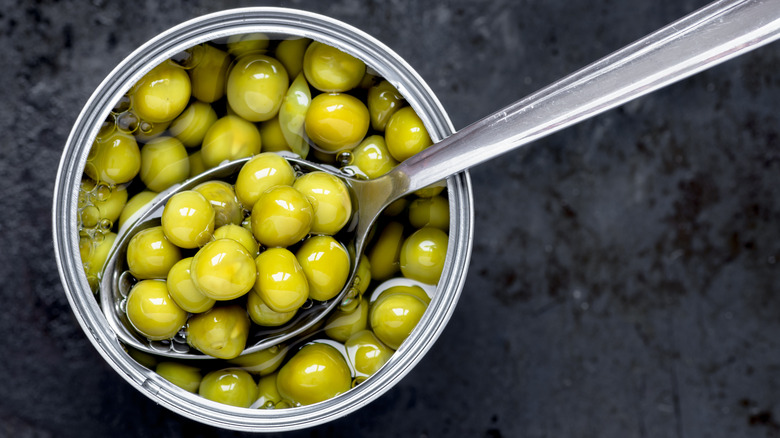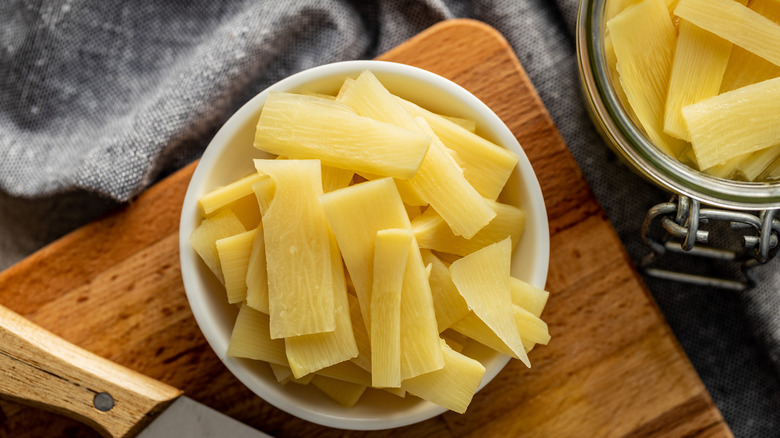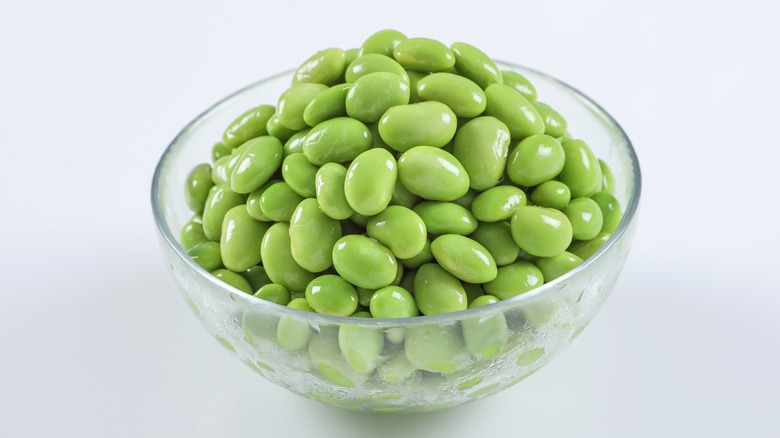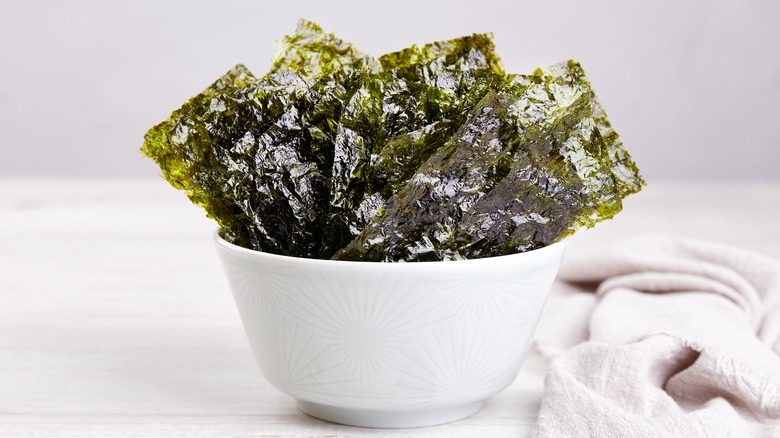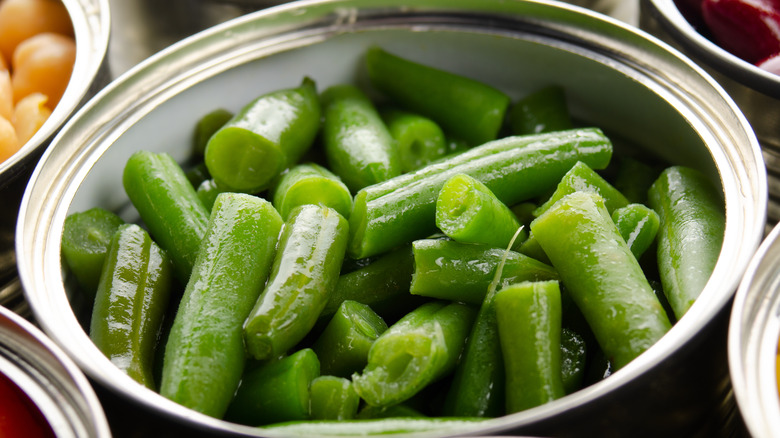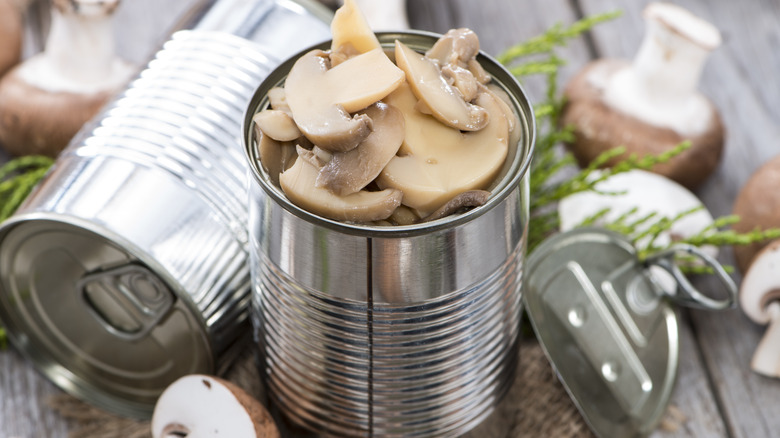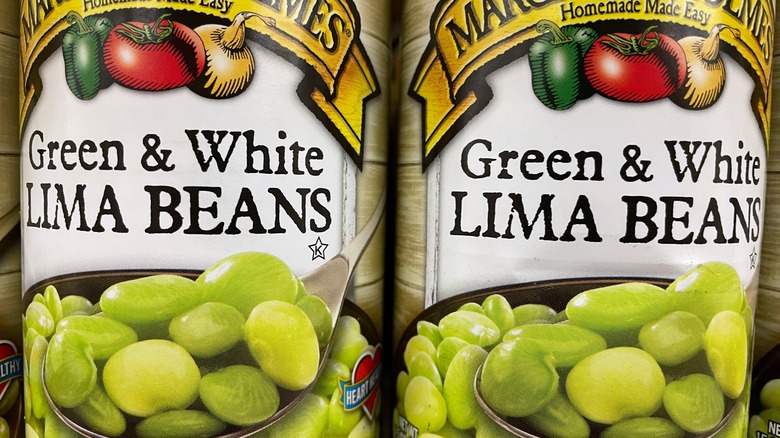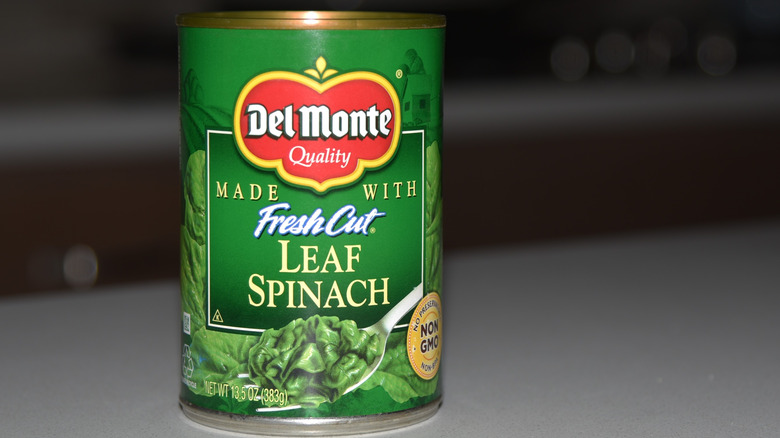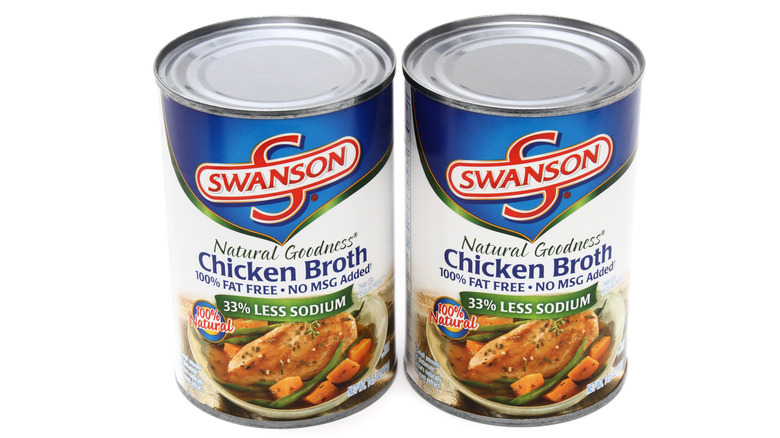Canned Ingredients That Will Take Your Ramen To Another Level
For many people, ramen evokes images of being a broke college student. However, this delicious Japanese soup with Chinese roots offers much more than a cheap package of noodles and powdered flavoring. Of course, you can always enjoy quality ramen soups at top-notch Asian restaurants, but when you want to make it at home, there are numerous ways to enhance the flavor by simply adding canned ingredients.
From soups to broths to veggies, an array of delicious canned foods can be added to easily, quickly, and cheaply take your ramen to another level. Chances are, you'll be surprised at how much of a difference a few ingredients can make, too. Let's learn about all the tasty canned foods that will take your ramen to another level. That way, you can stop eating boring ramen packets and enjoy delicious, healthy soup with minimal effort and profound benefits in every bowl.
1. Peas
Peas make the perfect addition to a hearty bowl of ramen. Not only are they inexpensive, but they are loved by almost everyone. Plus, canned peas are readily available at every grocery store, so you won't have to search too far for them. Another reason canned peas make a fantastic addition to ramen is that they add green veggies to your soup, so they are a quick and easy way to bolster nutrition. The splash of color also looks pleasing to the eye.
Thanks to their savory taste with a touch of sweetness, canned peas go wonderfully with any ramen flavor. The subtle sweetness of peas counterbalances spicier ramens, like chili, picante chicken, and lime chili shrimp flavors. The savory taste of peas also blends wonderfully with soy and meat-flavored ramens. From Chicken or pork or beef, you really can't go wrong when it comes to enhancing your ramen with canned peas. If you plan on adding other ingredients to your ramen, you probably don't want to add an entire can of peas to a single bowl, but feel free to add as many as you like.
2. Corn
Ramen and corn are a long-standing tradition. The sweetness of corn is delicious when added to springy ramen noodles and savory broths. In addition, corn is a standard ramen ingredient in many restaurants and authentic recipes, so it only makes sense to add canned corn to your ramen. You don't need a considerable amount, it is readily available, and it blends well with any broth flavor.
When it comes to adding canned corn to ramen, corn kernels are the most common selection. However, baby corn and even creamed corn also taste exceptionally well in ramen. Baby corn is typical in Chinese cuisine, so it obviously blends well with ramen's Asian flavors. While creamed corn may initially sound a little strange, many traditional ramen broths feature a creamy element that gives them a rich, hearty texture. For example, creamy chicken is a flavor of Maruchan ramen. You'll often find creamy broths in restaurants, too. With this in mind, creamed corn is the perfect way to elevate your homemade ramen and turn any flavor into a creamy delight.
3. Diced tomatoes
Tangy and bright, diced tomatoes are super versatile and delicious in a world of different dishes, ramen included. One of the best things about adding canned tomatoes to ramen is that the juices integrate with the other ingredients in expert fashion. The flavors seep into the noodles and any other ingredients, leading to drool-worthy flavors throughout the entire bowl. In fact, tomato broths are nothing new in Asian cuisine. Aside from various restaurants serving ramen with tomato broth, many traditional Chinese hot pot spots offer tomato broth.
For ramen, you can either use whole canned tomatoes and break them up into smaller pieces or use canned diced tomatoes. Either way, the tasty chunks, and maybe even a little bit of the juice, turn ramen broths into something special. Due to the versatility of tomatoes, you can add them to any ramen flavor. From soy to chicken to roast beef or shrimp, you won't find a ramen flavor that doesn't agree with canned diced tomatoes.
4. Water chestnuts
Water chestnuts may not be a typical ramen ingredient, but that doesn't mean you can't make them common when you prepare the soup at home. Typically, water chestnuts are used in Chinese stir-fries, such as chop suey, so taking the step to Japanese ramen is not really that big of a stretch. Many of the same Asian flavors and ingredients can be found in both dishes, like soy, noodles, meat, garlic, and more. Water chestnuts also have a crunchy texture that creates a wonderful combination with springy ramen noodles and other softer ingredients in the soup.
While canned water chestnuts don't have a ton of flavor all by themselves, they absorb any flavor you pair them with. In ramen, they soak up lots of broth and other spices, so not only do they take your ramen to another level, but your ramen also takes them to the next level. Really, it's a win on both sides. Water chestnuts also come in smaller-sized cans, allowing you to use the whole container in a single bowl. As an added bonus, you won't have to find a way to use the leftovers like you will with other canned ingredients.
5. Bamboo shoots
The slightly sweet and earthy taste of bamboo shoots makes them an excellent ramen enhancement. Some bamboo shoots have a tangy, bitter flavor, but when you buy them canned, the bitterness is largely eliminated, leaving you with a delicious, versatile ingredient. Bamboo shoots are predominantly used in Asian cuisine, ramen included, and taste great with any broth flavor. In addition, many restaurants use them in their ramen recipes, so you may have even tried this combination before.
Aside from the earthy taste, one of the best things about adding bamboo shoots to your ramen is that they come with a range of health benefits. They are low in fat and calories and are considered a good source of protein. They also contain lots of soluble fiber and vitamins, like B6, A, E, and niacin. Lastly, bamboo shoots have been associated with benefits like better digestive functioning, increased weight loss, and lowered cholesterol levels. So, really, you have nothing to lose and everything to gain when adding them to your ramen.
6. Shelled edamame
As you probably know, edamame is a common ingredient in Asian cuisine, and it is regularly included in restaurant and traditional ramen recipes. So, it's basically guaranteed to taste incredible in your homemade noodle soup. The only drawback to edamame is that it isn't as easy to find the canned version as other options on our list. If you can't locate it in a can, head over to the freezer section of your grocery store. Just make sure to get it pre-shelled so it can easily be added to your ramen.
In addition to tasting amazing in every flavor of ramen, edamame is really good for you. It is a complete protein, which means it contains all of the essential amino acids. It is also rich in vitamins and minerals, like iron, fiber, and omega-3 fatty acids. According to Healthline, edamame may also lower cholesterol, regulate healthy blood sugar levels, support heart health, minimize menopause symptoms, and might even reduce the risk of some cancers. As a result, it is an outstanding way to turn your tasty ramen into a health-conscious dish. Whether you do it for the health benefits, taste, or a splash of fresh color, shelled edamame is one of the best ingredients to add to ramen.
7. Nori AKA seaweed
Nori, or seaweed as we like to call it in the United States, is another common ingredient in ramen recipes. While there are different types of seaweed, nori is the most recognizable, probably because it is used to wrap sushi. Whatever you call it, seaweed is known for its potent umami flavor, which is meaty, salty, and also a touch fishy. It gives ramen a traditional flavor boost without having to add other less healthy ingredients to the mix.
You may be wondering, doesn't nori come in a flat plastic wrapper, similar to a stack of paper? The answer is yes, but you can also find it in a tin. So, technically, it is still a canned food. Regardless of the packaging, nori is the perfect authentic addition to your ramen. It can be shredded and added to the broth. Or, you can simply garnish the top of the soup with a small sheet of nori and gradually mix it into the bowl as you eat. Either way, nori is also exceptionally good for you. It is rich in fiber, protein, vitamins, and minerals, so it is delicious and healthy.
8. Green beans
If you're looking for another way to add green veggies to your ramen, green beans are just the thing. They have an earthy, starchy, buttery flavor profile with a subtle bitterness, making them an excellent complement to ramen. Green beans taste great with shrimp, beef, pork, chicken, soy, and chili ramen, so feel free to enhance any flavor of broth you like with them. Thanks to their elevated potassium, calcium, and vitamins C and K levels, green beans are also good for you. Of course, canned green beans will not be quite as healthy as raw or lightly cooked green beans, but they are still healthy nonetheless.
Canned green beans come in various formats, and they all taste great in ramen. French-style green beans are cut on the ends and also sliced down the middle longways, creating thin slivers perfect for ramen. Regular cut green beans, also called farmhouse-style green beans, come in smaller pieces, but they have a bit more crunch than French-style green beans, which many people prefer. Lastly, Italian green beans also make a fantastic addition to ramen. They are similar to regular cut green beans but have a flatter, wider surface and, often, even more crunch.
9. Carrots
Deliciously sweet and packed with nutrition, carrots are loved by almost everyone, even picky kids. They are also a common ramen ingredient, so adding some canned ones to your soup bowl is by no means out of the ordinary. The only real difference is that traditional ramen recipes typically use shredded carrots, and canned carrots are sliced into small discs. While the shape, thickness, and cut of a carrot can change how you enjoy it somewhat, that doesn't mean canned carrots should be excluded from your ramen bowl. Sliced carrots taste just as good in ramen, and canned carrots are much softer, so they effortlessly blend into the bowl's other flavors.
This probably goes without saying, but carrots are also nutritious. You have likely heard about how they are good for your vision because they're a source of beta-carotene, but they also contain lots of healthy B vitamins, like niacin and B6, and a good amount of vitamin C. They can also help with balancing blood sugar, weight management, improving immunity, reducing heart disease, regulating blood pressure, boosting brain health, and lowering your risk for cancer (per Health). With all this in mind, adding carrots to your ramen seriously helps you take it to the next level.
10. Spicy peppers
Adding spicy elements to ramen is nothing new. It doesn't have to be spicy, but many people prefer it that way. From chili garlic sauce to sliced jalapeños to chili crisp being marinated in the broth, adding heat is not only common, but it is a main component of many traditional ramen recipes. There is even a chili-flavored Maruchan ramen. It may not be available in all grocery stores, but it is well worth a try if you come across it and like heat. Don't worry if you can't find it, though. You can always add some canned peppers of your own to get the same spiciness and satisfy your cravings for heat.
Jalapeños are one of the most common spicy peppers used in ramen, and fortunately, they are also the most readily available canned spicy pepper. You can easily find both sliced and diced jalapeños at almost any grocery store, making them a convenient and tasty ramen additive. If you want to branch out a bit and try something new, you can also find other types of spicy canned peppers in the Hispanic section of most grocery stores. Diced green chilis, whole poblanos, and chipotle peppers come in cans, and while they may not be a typical ramen ingredient, they all taste great when added to the broth or put on top as a garnish. They also tend to be slightly less spicy, so they are perfect if you prefer a milder heat level.
11. Mushrooms
Canned mushrooms are another way to achieve the prized umami flavor found in lots of Asian dishes, including ramen. They have a meaty, earthy, and often woodsy flavor that closely resembles the desired umami taste of Asian cuisine. Actually, lots of restaurants and traditional recipes make ramen with mushroom broth, so they seamlessly fit into the flavor profile of ramen. They can be added to any flavor of ramen, from meat to soy to chili, and the result is delicious.
When it comes to buying mushrooms in a can, most of them are white mushrooms. However, strawberry, button, and shiitake mushrooms can also be found in a can at some grocery stores. Regardless of what type you prefer or are able to locate, they generally come sliced or as pieces and stems. Both configurations taste great in ramen and easily take it to the next level. In addition, all of them are brined, so you can open the can and add them straight to your ramen without worrying about additional prep work.
12. Lima beans
Lima beans are not a typical or traditional ramen ingredient, but that doesn't mean you can't toss them in your bowl to add some color and nutrition. Actually, you probably won't find a vegetable that doesn't taste great in ramen because it is an exceptionally adaptable soup. Lima beans are particularly delicious in ramen because they are similar to edamame, which, as we know, is a traditional ingredient in Asian cuisine. Sure, lima beans have a more buttery taste, but they are also nutty and slightly sweet, just like edamame.
Lima beans are a popular canned ingredient, so you won't have any issues finding it at the store. While they can also be purchased frozen and dried, many people prefer to buy them canned because they are easy to cook with. You don't have to worry about soaking them overnight, and you don't need any space for them in the freezer. Simply open a can of lima beans, drain them, add them to your ramen, and you are good to go.
13. Spinach
Typically, fresh greens like bok choy and spinach are used in ramen, but canned spinach works just as well. It contains all the same vitamins and minerals, albeit in smaller amounts, and also has a similar flavor. Aside from texture, the main difference between canned and fresh spinach is that canned spinach is much more dense. As a result, you'll want to use significantly less in your ramen. Otherwise, it can easily overpower the other ingredients and become the main event, and we all know the noodles need to be the star of your bowl.
Something you may not know is that rinsing your canned spinach is recommended. While it can be eaten straight from the can, like Popeye, rinsing canned spinach helps remove a significant amount of excess salt. Once extra salt is removed, canned spinach is still viewed as a highly nutritious food. It contains a massive amount of vitamin K and lots of vitamins A and C. Spinach also has a good amount of iron and potassium, so adding it to your ramen is a fantastic way to enhance nutrition and flavor simultaneously.
14. Canned broth
Ramen noodles can be purchased all by themselves, but they generally come in a package with a small powdered flavor packet included. While using the packets is fine, it is often best to make your own broth and throw the flavor packet out; cue canned broths. They come in all the typical stock flavors, including chicken, vegetable, beef, and fish, and often have some additional spices. When you substitute canned broth, you wind up with a rich, savory broth that blows the typical powdered flavor packet out of the water (pun intended).
If you want to upgrade your ramen but still want it to be easy to make, canned broth is a fantastic place to start. It allows you to hand-pick the base flavor and build on it with other ingredients any way you like. Plus, it has a much more potent taste overall, which seeps into the noodles and packs the other ingredients with rich flavor. So, move over powdered flavor packets; canned broths are here to take your place permanently.
15. Creamed soups
Creamed soups are the most surprising way to take your ramen to another level, but that doesn't mean they aren't delicious. Similar to broths, cans of creamed soup have a rich, hearty taste. They also have a decadent texture that only tastes better with the addition of ramen noodles. Cans of creamed soup come in a broad range of flavors, probably more than you're aware of, and luckily for us, most of them make a fantastic ramen base. Cream of tomato, potato, mushroom, chicken, and onion make the most sense based on classic ramen flavors and broths. However, cream of celery, broccoli, and asparagus also taste yummy with ramen noodles. Don't be afraid to try something unexpected. As long as you build on top with complementary flavors, it will turn out great.
If you want to make the most of this canned soup hack for richer ramen, there are several methods to try. First, substitute the flavor packet and water for a can of your favorite creamed soup. Second, you can try using the flavor packet along with a creamy soup to achieve extra bold flavors. Third, use half a can of creamed soup and half water. This ratio creates the perfect blend of flavor and creaminess, and it is the same consistency as creamy ramen broths you would find on a restaurant menu.


